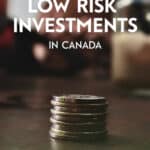The Best Low-Risk Investments in Canada

Low-risk investments may not earn double-digit returns, like a hot tech stock or ETF, but what they do offer can be just as valuable. When you choose a low-risk investment, your primary goal isn’t high returns.
You want to know that your capital will be safe and that you can get your money when you need it. If it happens to earn some interest, that’s even better.
With interest rates rising sharply over the past 18 months, low-risk investments are more appealing than they’ve been in many years. But with so many options, where should you put your money?
To help, I’ve compiled the following list of the best low-risk investments in Canada. But first, let’s take a look at some of the key characteristics of a safe investment.
Characteristics Of A Low-Risk Investment
While no investment product is exactly the same, many low-risk investments share similar characteristics. Here are some features you can expect to see when investing for safety.
A Principal Guarantee
Many low-risk investments are principal-guaranteed by the issuer. This means that your initial investment is protected, and you can expect to receive the total amount back, regardless of market fluctuations.
For example, savings accounts and GICs are guaranteed by the banks and credit unions that issue them, and Canadian T-Bills are guaranteed by the federal government. Government bonds are also guaranteed. Corporate bonds are guaranteed by the company that issues them. Corporate bonds carry a bit more risk than government bonds since the government is more financially secure than any individual company.
Not all low-risk investments are guaranteed. For example, money market mutual funds are considered a safety investment, but there is no principal guarantee.
Short-Term Durations
Most low-risk investors are looking to invest for the short term. For various reasons, they can’t commit to longer-term investments that come with higher volatility and increased risk.
For that reason, most low-risk investments have short-term durations. You can purchase GICs and T-bills with terms ranging from 30 days to 1 year (longer in the case of GICs). And savings accounts and money market funds don’t have any lock-in period; you can access your principal anytime.
Low Volatility
Low volatility is another key characteristic of low-risk investments. They tend to have a more stable and predictable return and are less affected by market ups and downs. Avoiding market risk leads to lower volatility and, consequently, a lower risk profile.
Lower Returns
Lastly, a common characteristic of low-risk investments is a lower return than higher-risk investments. As you minimize your exposure to market risks, the potential rewards are also limited. Although the returns may be lower, low-risk investments can provide a stable, predictable income and reassurance for investors who are prioritizing capital preservation.
The Best Low-Risk Investments In Canada
If you’re looking for a safe place to put your money, you’ll likely want to choose one of the following investment vehicles. But don’t focus solely on the interest rate, consider other important factors, like principal guarantees, liquidity, and simplicity, i.e. a savings account is much easier to purchase and understand than a corporate bond.
High-Interest Savings Account
A high-interest savings account is one of the safest investments you can make in Canada. It offers a higher interest rate than traditional savings accounts, helping you grow your money over time. These accounts are available at most financial institutions, but you’ll find the best interest rates are offered by online banks and some credit unions.
We’re big fans of EQ Bank’s Savings Plus Account, which has no fees and a competitive interest rate, and Tangerine Bank’s high-interest savings account, for the generous bonus interest it offers new customers.
Most savings accounts will be guaranteed by the issuer and protected by the Canadian Deposit Insurance Corporation (CDIC).
Guaranteed Investment Certificates (GICs)
Guaranteed Investment Certificates (GICs) are low-risk investments offered by Canadian banks and financial institutions. They offer a fixed return on your investment over a specific term, and the principal amount is guaranteed at maturity. GICs are protected by the Canadian Deposit Insurance Corporation (CDIC) up to certain limits, ensuring the safety of your investment.
Treasury Bills
Treasury bills (T-bills) are short-term, low-risk investments issued by the Government of Canada. They have a fixed maturity date and pay interest at a fixed rate. Since they’re backed by the government, they’re considered to be one of the safest investment options available to Canadians.
T-bills can be purchased through financial institutions and are an excellent choice for those looking for a secure way to generate income over the short term.
Government Savings Bonds
Government bonds, like treasury bills, are issued by a federal, provincial, or municipal government. They have a fixed interest rate and maturity date and the full backing of the government that gives them. Governments use bonds to raise money for many different purposes, including deficit financing and spending on infrastructure. As an investor, you are lending money to the government in exchange for a return on your investment.
Corporate Bonds
Corporate bonds are similar to government bonds but are issued by individual companies. Like governments, companies issue bonds as a way to raise money. They typically pay higher interest rates compared to government bonds, but they also come with a slightly higher risk.
Investing in corporate bonds is a good way to diversify your portfolio and receive income. However, always research the credit quality of the companies issuing the bonds and assess your personal risk tolerance before you invest.
Money Market Funds
A money market fund is a mutual fund that invests in short-term, high-quality securities, like treasury bills, commercial paper, and government bonds. They offer a higher return than traditional savings accounts but are not guaranteed. You can easily purchase money market funds through an investment advisor at your bank or invest on your own through an online broker.
Money market funds are a great option for those looking to earn a decent return over the short term while maintaining liquidity.
Fixed Annuities
Fixed annuities are long-term, low-risk investments offered by insurance companies. They provide a fixed income stream for a specific period or for life, depending on the contract. Fixed annuities can be an excellent choice for retirees looking for a guaranteed income stream. However, annuities aren’t for everyone. They require a long-term commitment, you lose control over your investment choices, and the fees can be very high.
Make sure you fully understand the terms and conditions of the annuity and the financial strength of the insurance company and always get a second opinion before you invest.
Dividend-Paying Stocks
Dividend-paying stocks are not necessarily low-risk investments. When you purchase a dividend stock, you are investing in the stock market and accepting the various risks that come with it. Dividend stocks are not guaranteed, and they do fluctuate in value like any other stock.
I’ve included them on this list for two reasons: First, dividend stocks allow you to generate passive income while you invest in the stock market. That’s because these stocks provide dividend payments to shareholders, offering a steady income source without selling your shares.
Also, companies that pay dividends tend to be high-quality, well-established companies. The most reliable dividend stocks in Canada include companies in the financial, telecommunications, utilities, and energy sectors.
Even though the best dividend stocks have lower volatility than many stocks that don’t pay dividends, they should still be considered long-term investments and are unsuitable if your primary objective is capital appreciation.
Final Thoughts
Most Canadian investors should have some portion of their portfolio in low-risk investments, regardless of their investment objective or risk tolerance. For example, your emergency fund should always be in a safe account where you can get to it quickly if you need access to it.
All of the investments on our list are high-quality, and with the exception of dividend-paying stocks, are considered very low-risk.
If liquidity is your main concern, open a high-interest savings account or money market fund. If you want a slightly higher rate and don’t mind locking in your funds for a period, then you may get a little better rate with a GIC. Bonds may offer even better rates but expect to hold them longer.
FAQs
What are some excellent investment options for beginners?
As a beginner, I recommend starting with a high-interest savings account, Guaranteed Investment Certificate (GIC), or money market fund. Once you gain knowledge and experience, you can explore other investment options.
What is the best way to invest a small amount of money?
When investing a small amount of money, you should focus on options with low fees and high liquidity. Consider setting up a high-interest savings account or GIC inside a Tax-Free Savings Account (TFSA).
Because a TFSA is tax-sheltered, you’ll get the added benefit of not paying income tax on the interest you earn. You can open a TFSA account with any major Canadian financial institution.
Where can I invest money for good returns with low risk?
If you have a larger sum of money to invest, but are unsure which low-risk investment vehicle is best, consider a mix of safe investments, like a savings account, GICs, or money market funds. All of these options will provide you with a better return than a regular bank savings account while maintaining low levels of risk.


